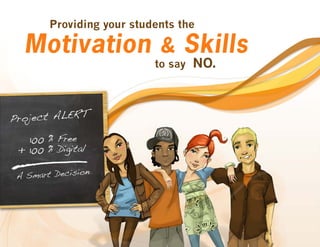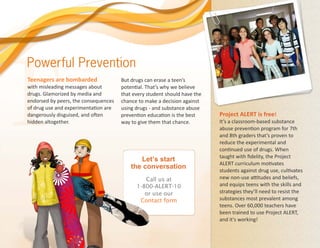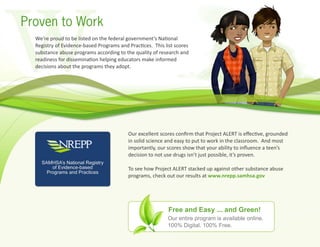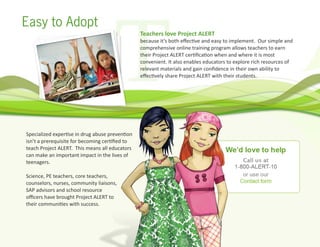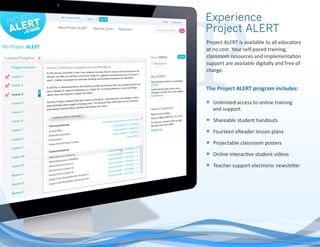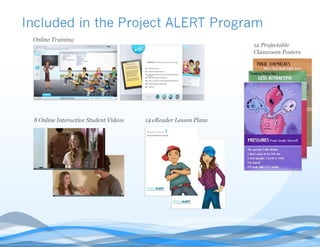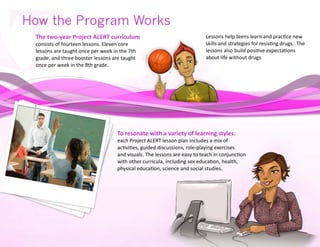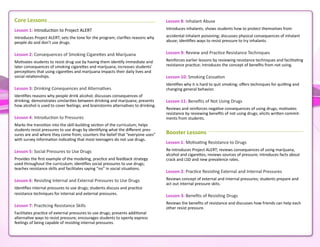Project alert brochure
- 1. School based, substance abuse prevention for grades 7 and 8. Two years that could change their lives. Prevention that¡¯s proven to work.
- 2. Providing your students the to say NO. Motivation & Skills
- 3. Let¡¯s start the conversation Call us at 1-800-ALERT-10 or use our Contact form But drugs can erase a teen¡¯s potential. That¡¯s why we believe that every student should have the chance to make a decision against using drugs - and substance abuse prevention education is the best way to give them that chance. Teenagers are bombarded with misleading messages about drugs. Glamorized by media and endorsed by peers, the consequences of drug use and experimentation are dangerously disguised, and often hidden altogether. Project ALERT is free! It¡¯s a classroom-based substance abuse prevention program for 7th and 8th graders that¡¯s proven to reduce the experimental and continued use of drugs. When taught with ?delity, the Project ALERT curriculum motivates students against drug use, cultivates new non-use attitudes and beliefs, and equips teens with the skills and strategies they¡¯ll need to resist the substances most prevalent among teens. Over 60,000 teachers have been trained to use Project ALERT, and it's working! Powerful Prevention
- 4. Our entire program is available online. 100% Digital. 100% Free. Free and Easy ... and Green! We¡¯re proud to be listed on the federal government¡¯s National Registry of Evidence-based Programs and Practices. This list scores substance abuse programs according to the quality of research and readiness for dissemination helping educators make informed decisions about the programs they adopt. Our excellent scores con?rm that Project ALERT is e?ective, grounded in solid science and easy to put to work in the classroom. And most importantly, our scores show that your ability to in?uence a teen¡¯s decision to not use drugs isn¡¯t just possible, it¡¯s proven. To see how Project ALERT stacked up against other substance abuse programs, check out our results at www.nrepp.samhsa.gov Proven to Work
- 5. Specialized expertise in drug abuse prevention isn¡¯t a prerequisite for becoming certi?ed to teach Project ALERT. This means all educators can make an important impact in the lives of teenagers. Science, PE teachers, core teachers, counselors, nurses, community liaisons, SAP advisors and school resource o?cers have brought Project ALERT to their communities with success. Teachers love Project ALERT because it¡¯s both e?ective and easy to implement. Our simple and comprehensive online training program allows teachers to earn their Project ALERT certi?cation when and where it is most convenient. It also enables educators to explore rich resources of relevant materials and gain con?dence in their own ability to e?ectively share Project ALERT with their students. Easy to Adopt
- 6. Project ALERT is available to all educators at no cost. Your self-paced training, classroom resources and implementation support are available digitally and free of charge. The Project ALERT program includes: ¡ñ Unlimited access to online training and support ¡ñ Shareable student handouts ¡ñ Fourteen eReader lesson plans ¡ñ Projectable classroom posters ¡ñ Online interactive student videos ¡ñ Teacher support electronic newsletter Experience Project ALERT
- 8. The two-year Project ALERT curriculum consists of fourteen lessons. Eleven core lessons are taught once per week in the 7th grade, and three booster lessons are taught once per week in the 8th grade. Lessons help teens learn and practice new skills and strategies for resisting drugs. The lessons also build positive expectations about life without drugs. To resonate with a variety of learning styles, each Project ALERT lesson plan includes a mix of activities, guided discussions, role-playing exercises and visuals. The lessons are easy to teach in conjunction with other curricula, including sex education, health, physical education, science and social studies. How the Program Works
- 9. Core Lessons Lesson 1: Introduction to Project ALERT Introduces Project ALERT; sets the tone for the program; clari?es reasons why people do and don¡¯t use drugs. Lesson 2: Consequences of Smoking Cigarettes and Marijuana Motivates students to resist drug use by having them identify immediate and later consequences of smoking cigarettes and marijuana; increases students¡¯ perceptions that using cigarettes and marijuana impacts their daily lives and social relationships. Lesson 3: Drinking Conequences and Alternatives Identi?es reasons why people drink alcohol; discusses consequences of drinking; demonstrates similarities between drinking and marijuana; presents how alcohol is used to cover feelings; and brainstorms alternatives to drinking. Lesson 4: Introduction to Pressures Marks the transition into the skill-building section of the curriculum; helps students resist pressures to use drugs by identifying what the di?erent pres- sures are and where they come from; counters the belief that ¡°everyone uses¡± with survey information indicating that most teenagers do not use drugs. Lesson 5: Social Pressures to Use Drugs Provides the ?rst example of the modeling, practice and feedback strategy used throughout the curriculum; identi?es social pressures to use drugs; teaches resistance skills and facilitates saying ¡°no¡± in social situations. Lesson 6: Resisting Internal and External Pressures to Use Drugs Identi?es internal pressures to use drugs; students discuss and practice resistance techniques for internal and external pressures. Lesson 7: Practicing Resistance Skills Facilitates practice of external pressures to use drugs; presents additional alternative ways to resist pressure; encourages students to openly express feelings of being capable of resisting internal pressures. Lesson 8: Inhalant Abuse Introduces inhalants; shows students how to protect themselves from accidental inhalant poisoning; discusses physical consequences of inhalant abuse; identi?es ways to resist pressure to try inhalants. Lesson 9: Review and Practice Resistance Techniques Reinforces earlier lessons by reviewing resistance techniques and facilitating resistance practice; introduces the concept of bene?ts from not using. Lesson 10: Smoking Cessation Identi?es why it is hard to quit smoking; o?ers techniques for quitting and changing general behavior. Lesson 11: Bene?ts of Not Using Drugs Reviews and reinforces negative consequences of using drugs; motivates resistance by reviewing bene?ts of not using drugs; elicits written commit- ments from students. Booster Lessons Lesson 1: Motivating Resistance to Drugs Re-introduces Project ALERT; reviews consequences of using marijuana, alcohol and cigarettes; reviews sources of pressure; introduces facts about crack and LSD and new prevalence rates. Lesson 2: Practice Resisting External and Internal Pressures Reviews concept of external and internal pressures; students prepare and act out internal pressure skits. Lesson 3: Bene?ts of Resisting Drugs Reviews the bene?ts of resistance and discusses how friends can help each other resist pressure.
- 10. Assessment Tools Knowledge and outcome based evaluation. Supplemental Resource Manual Tools for dealing with painkillers, sedatives, steroids and stimu- lants. Electronic Newsletters Teaching tips, new trends in substance abuse and other useful information. Proyecto ALERTA Spanish language lesson plans and home learning opportunities. A Or visit us at www.projectalert.com And the Support You Need...
- 11. 1-800-ALERT-10 info@projectalert.best.com www.projectalert.com 100% Digital. 100% Free. Project ALERT is a classroom-based substance abuse prevention program for 7th and 8th graders that¡¯s easy to adopt and proven to work. Begin your free training today at www.projectalert.com.


